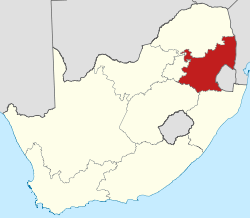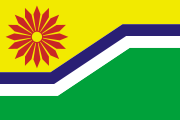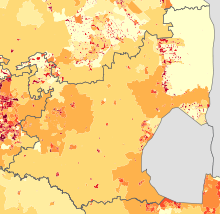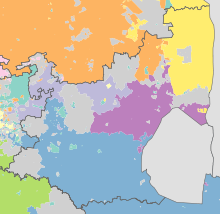- Mpumalanga
-
"Eastern Transvaal" redirects here. For the rugby team formerly known as "Eastern Transvaal", see Falcons (rugby team). For the team formerly called "South Eastern Transvaal" representing Mpumalanga, see Pumas (rugby team).
Mpumalanga — Province of South Africa — The Province of Mpumalanga 
Coat of armsMotto: Omnia labor vincit (Labour will conquer all) Location of Mpumalanga in South Africa Country  South Africa
South AfricaEstablished 27 April 1994 Capital Nelspruit (Mbombela) Districts Government – Type Parliamentary system – Premier David Mabuza (ANC) Area[1] – Total 76,495 km2 (29,534.9 sq mi) Area rank 8th in South Africa Highest elevation 2,331 m (7,648 ft) Population (2007)[2][3] – Total 3,643,435 – Estimate (2010) 3,617,600 – Rank 6th in South Africa – Density 47.6/km2 (123.4/sq mi) – Density rank 3rd in South Africa Population groups[4] – Black African 92.0% – White 6.8% – Coloured 0.8% – Indian or Asian 0.4% Languages[5] – Swati 29.4% – Zulu 24.1% – Tsonga 11.6% – Ndebele 10.3% – Northern Sotho 10.2% Time zone SAST (UTC+2) ISO 3166 code ZA-MP Website www.mpumalanga.gov.za Mpumalanga
 i/uːmˌpuːməˈlɑːŋɡə/ (name changed from Eastern Transvaal on 24 August 1995), is a province of South Africa. The name means east or literally "the place where the sun rises" in Swazi, Xhosa, Ndebele and Zulu. Mpumalanga lies in eastern South Africa, north of KwaZulu-Natal and bordering Swaziland and Mozambique. It constitutes 6.5% of South Africa's land area. In the north it borders on Limpopo, to the west Gauteng, to the southwest the Free State and to the south KwaZulu-Natal. The capital is Nelspruit (recently renamed to Mbombela). Prior to 1994, Mpumalanga was part of Transvaal Province.
i/uːmˌpuːməˈlɑːŋɡə/ (name changed from Eastern Transvaal on 24 August 1995), is a province of South Africa. The name means east or literally "the place where the sun rises" in Swazi, Xhosa, Ndebele and Zulu. Mpumalanga lies in eastern South Africa, north of KwaZulu-Natal and bordering Swaziland and Mozambique. It constitutes 6.5% of South Africa's land area. In the north it borders on Limpopo, to the west Gauteng, to the southwest the Free State and to the south KwaZulu-Natal. The capital is Nelspruit (recently renamed to Mbombela). Prior to 1994, Mpumalanga was part of Transvaal Province.Contents
Geography
The Drakensberg Escarpment divides Mpumalanga into a westerly half consisting mainly of high-altitude grassland called the Highveld and an eastern half situated in low altitude subtropical Lowveld/Bushveld, mostly savanna habitat. The southern half of the Kruger National Park is situated in the latter region. The Drakensberg exceeds heights of 2000m in most places with this central region of Mpumalanga being very mountainous. These regions have alpine grasslands and small pockets of Afromontane Forest. The Lowveld is relatively flat with interspersed rocky outcrops. The Lebombo Mountains form a low range in the far east forming the border with Mozambique.
Some of the oldest rocks on earth are to be found in the Barberton area and these ancient greenstones and metamorphosed granites form the Crocodile River Mountains in the south-east of the province. The Lowveld is underlaid by African Cratonic Basement rocks of ages in excess of 2 billion years. The Highveld is mostly Karoo Sequence sedimentary rocks of a younger, Carboniferous to Permian age.
- Gaza Province, Mozambique – northeast
- Maputo Province, Mozambique – east
- Lubombo District, Swaziland – east, southwest of Maputo Province
- Hhohho District, Swaziland – east, northwest of Lubombo
- Manzini District, Swaziland – east, south of Hhohho
- Shiselweni District, Swaziland – southeast, south of Manzini
Mpumalanga is the only province of South Africa to border two provinces of Mozambique or to border all four districts of Swaziland.
Climate
The Lowveld is subtropical, due to its proximity to the warm Indian Ocean and latitude. The Highveld is comparatively much cooler, due to its altitude of 2300m to 1700m above sea level. The Drakensberg Escarpment receives the most precipitation, with all other areas being moderately well-watered by mostly summer thunderstorms. The Highveld often experiences severe frost, whilst the Lowveld is mostly frost-free. Winter rainfall is rare, except for some drizzle on the escarpment. The differences in climate are demonstrated below by the capital, Nelspruit, which is in the Lowveld, located just an hour from Belfast on the Highveld.
- Nelspruit averages: January maximum: 29 °C (min: 19 °C), July maximum: 23 °C (min: 6 °C), annual precipitation: 767 mm
- Belfast averages: January maximum: 23 °C (min: 12 °C), June maximum: 15 °C (min: 1 °C), annual precipitation: 878 mm
Fauna and flora
The diverse and special flora and fauna of the province enjoys protection in a range of nature reserves, including:
- Blyderivierspoort Nature Reserve
- Great Limpopo Transfrontier Park, previously known as Gaza-Kruger-Gonarezhou Transfrontier Park. This international game park brings together some of the best and most established wildlife areas in southern Africa. The park is managed as an integrated unit across an unprecedented three international boundaries which includes the Kruger National Park (South Africa), Limpopo National Park (Mozambique) and Gonarezhou National Park (Zimbabwe).
- Sabi-Sand Game Reserve, which is built up of numerous private reserves: Idube Safari Lodge, Chitwa Chitwa Game Lodge, Djuma Game Reserve, Exeter Game Lodge, Inyati Private Game Reserve, Leopard Hills Private Game Reserve, Lion Sands Private Game Reserve, Londolozi Game Reserve, Mala Mala Game Reserve, Savanna Private Game Reserve and Ulusaba Game Lodge.
Law and government
Main article: Politics of MpumalangaThe Mpumalanga Province's legislation is an amalgam of national and regional legislation promulgated prior to the establishment of the province on 27 April 1994, and legislation which it has itself promulgated since it came into existence. Lists of and the original texts of this legislation are available through various South African governmental websites, and amended and updated versions of the legislation is available through commercial vendors on subscription and at a price. See External links for more information.
Municipalities
Mpumalanga Province is divided into three municipal districts, which are further subdivided into 17 local municipalities:
- Gert Sibande District
- Albert Luthuli
- Msukaligwa
- Mkhondo
- Pixley Ka seme
- Lekwa
- Dipaleseng
- Govan Mbeki
- Nkangala District
- Delmas
- Emalahleni
- Steve Tshwete
- Highlands
- Thembisile
- Dr JS Moroka
Economy
Agriculture
The climatic contrasts between the drier Highveld region, with its cold winters, and the hot, humid Lowveld allow for a variety of agricultural activities. More than 68% of Mpumalanga is utilised by agriculture. Crops include maize, wheat, sorghum, barley, sunflower seed, soybeans, groundnuts, sugar cane, vegetables, coffee, tea, cotton, tobacco, citrus, subtropical and deciduous fruit.
Forestry is extensive around Sabie in the far north of the province. Located near the forests, Ngodwana is the site of one of South Africa's largest paper mills (Sappi).[6]
Natural grazing covers approximately 14% of Mpumalanga. The main products are beef, mutton, wool, poultry and dairy.
Mining
Extensive mining is done and the minerals found include: Gold, Platinum group metals, Silica, Chromite, Vanadiferous Magnetite, Argentiferous Zinc, Antimony, Cobalt, Copper, Iron, Manganese, Tin, Coal, Andalusite, Chrysotile Asbestos, Kieselguhr, Limestone, Magnesite, Talc and Shale.
Gold was first discovered in Mpumalanga province in 1883 by Auguste Roberts in the mountains surrounding what is now Barberton. Gold is still mined in the Barberton area today.[7]
Mpumalanga accounts for 83% of South Africa's coal production. 90% of South Africa's coal consumption is used for electricity generation and the synthetic fuel industry. Coal power stations are in proximity to the coal deposits. A coal liquefaction plant in Secunda (Secunda CTL) is one of the country's two petroleum-from-coal extraction plants, which is operated by the synthetic fuel company Sasol.[8]
Tourism
Mpumalanga is also a popular tourism destination. Kruger National Park, established in 1898 for the protection of Lowveld wildlife, covering 20,000 square kilometres (7,700 sq mi), is a popular destination.[9] The other major tourist attractions include the Sudwala Caves and the Blyde River Canyon.
The various towns in the region have much to offer, like the African Silk farm near Graskop, The coffee farm nearby. Many activities including The big jump, mountain and quad biking, horse trails, river rafting and big game viewing are endemic to the region. This is Big 5 territory. The towns in the Lowveld, comprise of Barberton, Mbombela, White River, Sabie, Graskop. Hazyview, Malelane, Pilgrim's Rest, Lydenburg and Nkomazi.[10]
In 2008 a Haute Cuisine route was formed, trickling from Mbombela down to Hazyview, the Lowveld Gourmet Route covers the four top fine dining restaurants the area has to offer. The restaurants include Summerfields Kitchen, Oliver’s Restaurant, Orange and Salt.[11]
Demographics
Some 30% of the people speak siSwati, the language of neighbouring Swaziland, with 26% speaking isiZulu and 12% isiNdebele.
See also
- List of Speakers of the Mpumalanga Provincial Legislature
References
- ^ Stats in Brief, 2010. Pretoria: Statistics South Africa. 2010. p. 3. ISBN 978-0-621-39563-1. http://www.statssa.gov.za/publications/StatsInBrief/StatsInBrief2010.pdf.
- ^ "Community Survey 2007: Basic results" (PDF). Statistics South Africa. p. 2. http://www.statssa.gov.za/publications/CS2007Basic/CS2007Basic.pdf. Retrieved 14 January 2011.
- ^ Mid-year population estimates, 2010 (Report). Statistics South Africa. 2010. http://www.statssa.gov.za/publications/P0302/P03022010.pdf. Retrieved 14 January 2011.
- ^ "Statistical release P0301: Community Survey, 2007 (Revised version)" (PDF). Statistics South Africa. p. 25. http://www.statssa.gov.za/publications/P0301/P0301.pdf. Retrieved 7 October 2009.
- ^ "Table: Census 2001 by province, language, population group and gender.". Census 2001 Interactive Tables. Statistics South Africa. http://www.statssa.gov.za/timeseriesdata/pxweb2006/Dialog/varval.asp?ma=Language%20by%20province&ti=Table%3A+Census+2001+by+province%2C+language%2C+population+group+and++gender%2E&path=../Database/South%20Africa/Population%20Census/Census%202001%20-%20NEW%20Demarcation%20boundaries%20as%20at%209%20December%202005/Provincial%20level%20-%20Persons/&lang=1. Retrieved 28 January 2010.
- ^ Mpumalanga in brief: The economy of the province (URL accessed 30 April 2006)
- ^ "Barberton", Mpumalanga South Africa, ExploreSouthAfrica.net. (URL accessed 30 April 2006)
- ^ "Coal", South Africa Country Analysis Brief, Energy Information Administration. (URL accessed 30 April 2006)
- ^ "Kruger National Park", South Africa Explored.
- ^ Mpumalanga news
- ^ Mpumalanga Haute Cuisine
External links
 Administrative divisions of South Africa
Administrative divisions of South AfricaProvinces Eastern Cape • Free State • Gauteng • KwaZulu-Natal • Limpopo • Mpumalanga • North West • Northern Cape • Western Cape
Municipalities Buffalo City (East London) · Cape Town · Ekurhuleni (East Rand) · eThekwini (Durban) · Johannesburg · Mangaung (Bloemfontein) · Nelson Mandela Bay (Port Elizabeth) · Tshwane (Pretoria)of the Eastern Cape · of the Free State · of Gauteng · of KwaZulu-Natal · of Limpopo · of Mpumalanga · of the North West · of the Northern Cape · of the Western Cape · Full listSettlements in the Eastern Cape · in the Free State · in Gauteng · in KwaZulu-Natal · in Limpopo · in Mpumalanga · in the North West · in the Northern Cape · in the Western CapeProvince of Mpumalanga, South Africa Provincial Capital: NelspruitDistrict
and Local
MunicipalitiesCategories:- Mpumalanga
- Provinces of South Africa
- States and territories established in 1994
Wikimedia Foundation. 2010.




